Knowing the basics
Wisdom teeth removal is one of the most common dental procedures performed on patients. Some people are lucky enough to be born without wisdom teeth. But in most cases, people will have one to four teeth that will need to be removed.
The reason this procedure is so important, is because you’ll be able to avoid pain and discomfort in the future. When wisdom teeth grow in, it crowds the mouth and causes teeth misalignment. This can lead to problems with your bite.
We like to do wisdom teeth removal procedures during adolescence to avoid these issues. Younger patients are also able to recover much faster from the surgery.

What to do after your wisdom teeth removal
Step 1
The gauze pad placed over the surgical area should be kept in place for a half hour. After this time, the gauze pad should be removed and discarded.
Step 2
Regular exams and cleanings will prevent more costly dental procedures in the future. We recommend visiting Sunnyside Dental Center at least twice a year to ensure a healthy smile.
Step 3
Take the prescribed pain medications as soon as you begin to feel discomfort. This will usually coincide with the local anesthetic becoming diminished.
Step 4
Restrict your activities the day of surgery and resume normal activity when you feel comfortable.
Step 5
Place ice packs on the side of your face where surgery was performed. You’ll notice areas on your cheekbones that are swollen. These will be where you place the ice packs.
Frequently Asked Questions
Wisdom teeth are the third and final set of molars that most people get in their late teens or early twenties. Sometimes these teeth can be a valuable asset to the mouth when healthy and properly aligned, but more often, they are misaligned and require removal.
When wisdom teeth are misaligned, they may position themselves horizontally, be angled toward or away from the second molars, or be angled inward or outward. Poor alignment of wisdom teeth can crowd or damage adjacent teeth, the jawbone, or nerves.
Wisdom teeth also can be impacted — they are enclosed within the soft tissue and/or the jawbone or only partially break through or erupt through the gum. Partial eruption of the wisdom teeth allows an opening for bacteria to enter around the tooth and cause an infection, which results in pain, swelling, jaw stiffness, and general illness. Partially erupted teeth are also more prone to tooth decay and gum diseas,e because their hard-to-reach location and awkward positioning makes brushing and flossing difficult.
The word periodontal literally means “around the tooth.” Healthy gums tissue fits like a cuff around each tooth, where the gum line meets the tooth, it forms a slightly v-shaped crevice called a sulcus. In healthy teeth, this space is usually three millimeters or less.
Periodontal diseases are infections that affect the tissues and bone that support teeth. As the tissues are damaged, the sulcus develops into a pocket that is greater than three millimeters. Generally, the more severe the disease, the greater the pocket depth and bone loss. The enlarged pockets allow harmful bacteria to grow and make it difficult to practice effective oral hygiene. Left untreated, periodontal diseases may eventually lead to tooth loss. Periodontal Disease has also been linked recently to Heart Disease.
The mouth is filled with countless bacteria. Periodontal disease begins when certain bacteria in plaque (the sticky, colorless film that constantly forms on the teeth and surfaces lining the mount) produce toxins and enzymes that irritate the gums and cause inflammation. The resulting inflammation, which may be painless, can damage the attachment of the gums and bone to the tooth.
If Plaque is not removed regularly it can harden into rough porous deposits called calculus, or tarter. The tartar’s pores hold bacteria and toxins, which are impossible to remove even with regular brushing. The only way to remove the tartar is to have it professionally removed in a dental office.
If you notice any of the following:
- Gums that bleed easily
- Red, swollen,or tender gums
- Gums that have pulled away from your teeth
- Persistent bad breath
- pus between the teeth and gums
- Loose or separating teeth
- A change in the way your teeth fit together when you bite
- A change in the fit of partial dentures
You need to see your dentist to have your gums evaluated by the dentist or dental hygienist.
A bridge helps maintain the natural shape of your face and may help support your lips and cheeks. The loss of a back tooth may cause your mouth to sink and your face to look older. When a tooth is lost, the nearby teeth may move up or down toward the space. The places unusual stress on both the teeth and tissues in your mouth.
In addition, the gum tissues and the bone that hold teeth in place can break down, increasing the risk of gum disease. Teeth that have tipped are difficult to clean, making them for likely to decay. As a result, even more teeth may be lost.
A fixed bridge is commonly cemented to the natural teeth next to the space left by the missing tooth. A false tooth (called a pontic) replaces the lost tooth. The pontic is attached to the crowns.
Nothing can take the place of a healthy set of teeth, but when disease or and accident ends in tooth loss, it’s good to know you have some options in restoring your smile.
Implants are metal posts or frames that are surgically placed beneath your gums. After placement the implants0plats fuse to the bone of your jaw and act as artificial tooth roots. Replacement teeth – singularly or grouped on a bridge or denture – are then mounted to the implant.
Not all patients may be able to have implants as an option to replacing a missing tooth. Candidates need to have healthy gums and adequate bone to support an implant. Candidates must be in overall good health.
In our experience, we recommend removing wisdom teeth if they don’t fully emerge. Many dentists believe it’s better to remove wisdom teeth at a younger age, before the roots and bone are fully formed, and when recovery is generally faster after surgery. This is why some young adults have their wisdom teeth pulled before the teeth cause problems.
But you can still wait to get your wisdom teeth removed at a later stage in life. Like we mentioned earlier, it just may take a little longer to recover from that procedure.
Usually we like to start seeing Children on a regular basis around the age of 3. We find that at this age they are better able to communicate with us, and understand what we are telling them. We do see children that are younger that 3 if the parent sees something in there mouth that they are concerned about.
You should start brushing your child’s teeth as soon as they come in. Do not give them a bottle with anything but water in it to go to sleep or for naps.
A sealant is a plastic material that is usually applied to the chewing surfaces of the back teeth – premolars and molars. This plastic resin bonds into the depressions and grooves (pit and fissures) of the chewing surfaces of back teeth. The sealant acts as a barrier, protecting enamel from plaque and acids. Sealants do not protect the teeth from decay in between the teeth. The best way to prevent decay from forming between the teeth is to floss daily and brush 2-3 times a day.
As long as the sealant remains intact, the tooth surface will be protected from decay. Sealants hold up well under the force of normal chewing and usually last several years before a reapplication is needed. During your regular dental visits, your dentist will check the condition of the sealants and reapply them when necessary.
Though brushing and flossing help remove food particles and plaque from smooth surfaces of teeth. Pits and fissures, however, are places that are extremely difficult to clean. Toothbrush bristles cannot reach all the way into the depressions and grooves to extract food and plaque.
The normal flow of saliva, which helps clean food particles from other areas of the mouth, cannot “wash out” pits and fissures, so they are places that are especially prone to decay. In fact, most cavities form in pit and fissure areas, and permanent molars are extremely susceptible to this form of decay. Sealants protect these vulnerable areas by “sealing out” plaque and food.
A crown is a restoration that covers, or caps, a tooth to restore it to its normal shape and size. Its purpose is to strengthen or improve the appearance of a tooth. A crown is placed for a number of reasons.
- to support a large filling when there is not enough tooth remaining
- to attach a bridge
- to protect weak teeth from fracturing
- to restore fractured or cracked teeth
- to cover badly shaped or discolored teeth
- to cover a dental implant
Several steps are involved in placing a traditional crown. Usually at least two visits are necessary. The dentist will prepare the tooth by removing the outer protion of your tooth to accommodate the thickness of the crown. If the tooth has a filling, part of the material may be left in place to serve as as foundation for the crown. An impression is made to provide and exact model of the prepared tooth. Your dentist or dental laboratory technician, following the written instruction of the dentist, will then make the crown from the model.
